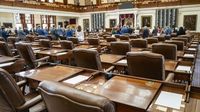On Saturday, August 16, 2025, the simmering debate over Texas’s redistricting plan is set to erupt into nationwide protests, with events planned in at least 34 states. The focal point? The so-called "Fight the Trump Takeover" rallies, which organizers say are aimed at resisting what they claim is an attempt by President Trump to "steal the 2026 election by rigging the system and changing electoral maps," as reported by Axios.
While the redistricting fight is centered in Texas, its ripple effects are being felt across the country, drawing in national political figures and raising alarms in local communities. In North Texas, only a single protest is planned for Saturday, a stark contrast to previous years when thousands would gather across Dallas-Fort Worth to oppose Trump administration policies. This time, the anchor rally will take place at 11 a.m. at the Capitol in Austin, led by U.S. Representatives Greg Casar and Lloyd Doggett, alongside former U.S. Representative Beto O’Rourke — all prominent Democrats.
But the battle lines stretch far beyond the statehouse steps. In Houston’s Denver Harbor neighborhood, a predominantly Latino community, residents are feeling the immediate impact of the redistricting fight. The area is home to small businesses and families who have grown increasingly anxious about immigration and deportations. Rene Porras, a Vietnam combat veteran and owner of a local taqueria, has seen his business suffer in recent weeks. "Business is down for the last three or four weeks. I mean, really down. And I talked to my other friends that have businesses and the same thing. Where did the immigrants go?" Porras told Houston Public Media.
Community activist Rita Robles echoed these concerns, pointing to the visible presence of Immigration and Customs Enforcement (ICE) in the area. "When they started saying that ICE was going to be in the area, we've spotted them in certain areas where they're huddling together, before they go do a raid, and that has scared the hell out of the people here," Robles said. The fear of mass deportations is just one element of President Trump’s broader agenda, which has found support among the Republican majority in Congress — though that majority is narrow and increasingly contentious.
To shore up GOP prospects in the 2026 elections, President Trump has called for Texas lawmakers to redraw the state’s congressional map, with the explicit goal of creating five more Republican-held seats. According to NPR, Democrats in the Texas House of Representatives have responded by leaving the state, denying Republicans the quorum needed to vote on the new maps. Governor Greg Abbott, a staunch Trump ally, has threatened to have the absent lawmakers arrested or removed from office if they do not return. For now, those Democrats appear poised to come back, with House Democratic Caucus chair Gene Wu stating, “As Democrats across the nation join our fight to cause these maps to fail their political purpose, we’re prepared to bring this battle back to Texas.”
The stakes are high for neighborhoods like Denver Harbor. Currently represented in Congress by Democratic Rep. Sylvia Garcia, the area faces a dramatic shift under the proposed maps. The Texas Legislative Council, which provides research and analysis for state lawmakers, found that while Denver Harbor’s current district voted for Kamala Harris in the last presidential election, the new district it would be merged into went for Donald Trump by a wide margin. The change would move Denver Harbor out of its urban, Democratic-leaning enclave and into a district dominated by suburbs and exurbs — areas with very different political and economic profiles.
Porras, the taqueria owner, doesn’t mince words about his neighbors’ feelings: "Since Trump's proposed this, he's so unpopular around here it's incredible. Everything from cutting services and Medicaid, all the things he didn't mention during the election, or said he's not going to cut, that's exactly what he's doing." For Robles, the redistricting raises concerns beyond politics, especially when it comes to environmental health. Denver Harbor sits just a few miles from the Houston Ship Channel, an area notorious for air pollution. "We have a very big problem with air pollution. We already have a large number of people in our area that suffer from health problems, and then on top of that, you suffer from things like asthma, emphysema," Robles explained. She also worries that merging Denver Harbor with wealthier, less pollution-affected suburbs would dilute the community’s ability to advocate for its unique needs. "They make six figures, you know, anywhere from $50,000, $60,000 and up to six figures. They don't have these types of problems that we do."
Republican leaders, for their part, defend the new maps as a fair reflection of demographic changes in Harris County. Cindy Siegel, chair of the Harris County Republican Party, told Houston Public Media, "The way the new maps are drawn is really more indicative of how Harris County has changed demographically." She also claimed that Democrats are upset because they have "taken Hispanic voters for granted, and now they pay a price for it." Siegel pointed to what she described as a shift in Hispanic voter support toward President Trump in the last election cycle.
Texas House Majority Leader Tom Oliverson, a Republican representing Cypress in northwest Harris County, was more blunt about the political motivation behind the redistricting. "I think it's well within our right to do so. There are many, many states where redistricting for partisan performance has been a way of life for 20, 30 years, particularly in Democrat states," Oliverson said. Yet, this kind of redistricting — sometimes labeled as partisan gerrymandering — can overlap with racial gerrymandering, which is illegal under federal law. Michael O. Adams, a political science professor at Texas Southern University, warned that the apparent Hispanic majority in the proposed district is misleading. "I think what we're seeing here, and what we're witnessing in this redistricting proposal and the midterm cycle, is what I would call a master class in demographic manipulation," Adams said.
It’s worth noting that the Supreme Court, in a 2019 decision, eliminated federal guardrails against partisan gerrymandering, giving states like Texas more leeway to redraw maps for political advantage. This has emboldened leaders such as Governor Abbott, who has already announced plans to call a second special session to push the redistricting plan forward.
Meanwhile, the fight is not contained to Texas alone. Democratic leaders in California are reportedly considering their own redistricting efforts to counter Texas’s move, while Republican-led states like Missouri and Florida are weighing similar strategies. Traditionally, redistricting occurs early in the decade after the census, but President Trump’s push could upend that norm, making the process a perpetual battleground.
As the anchor rally in Austin kicks off and protests echo across the nation, the outcome of Texas’s redistricting battle may well shape not only the state’s political landscape but also the broader struggle over voting rights and representation in America. For communities like Denver Harbor, the stakes couldn’t be more personal — or more urgent.




